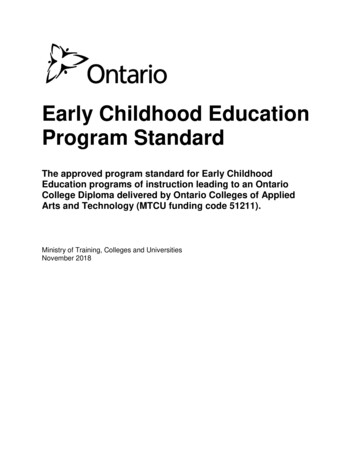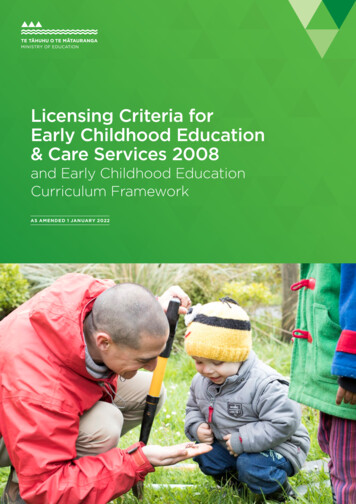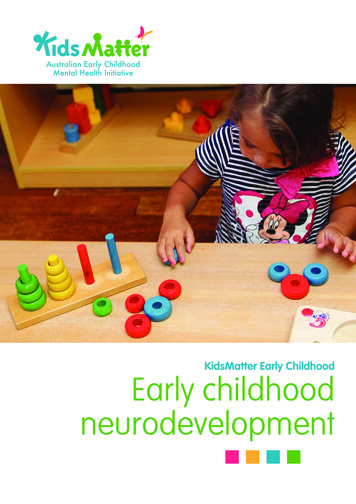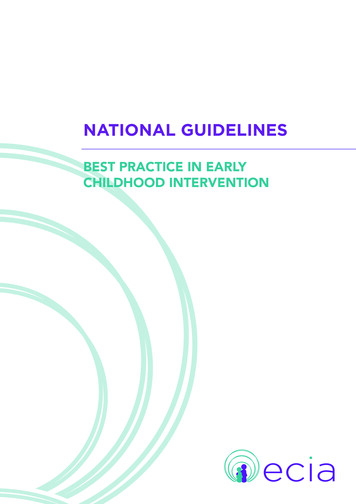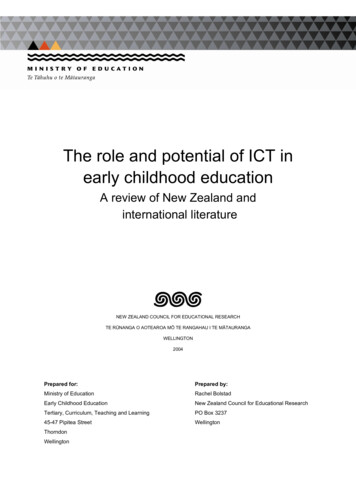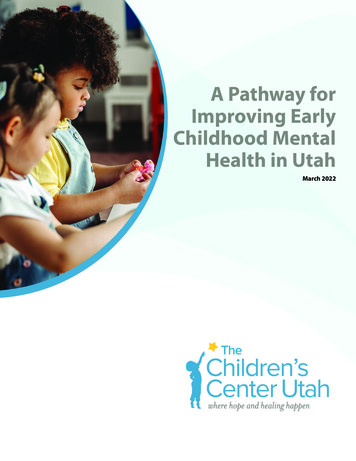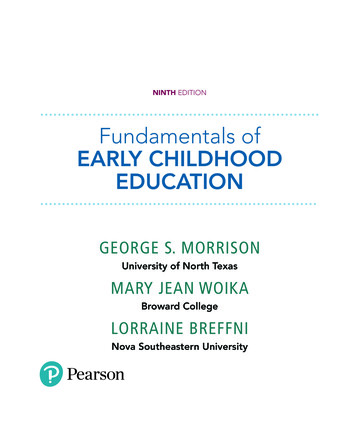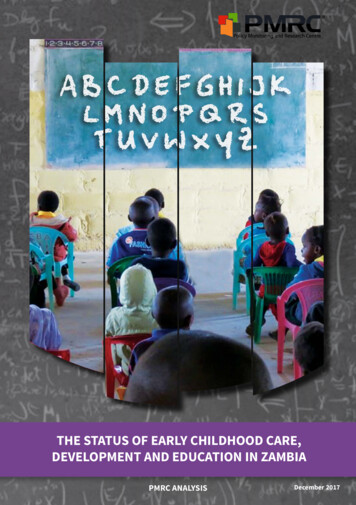
Transcription
THE STATUS OF EARLY CHILDHOOD CARE,DEVELOPMENT AND EDUCATION IN ZAMBIAThe Statusof Early Childhood Care, Development and Education inDecemberZambia 20171PMRCANALYSIS
PREPARED BY:RESEARCH:Leya Namonje (Junior Researcher) with the support of Bernadette Deka (Executive Director)TECHNICAL REVIEW:Salim Kaunda (Head of Research and Analysis)EDITORIAL TEAM:Brian Sambo Mwila - (Communication Specialist) - Layout and DesignMelody Simukali - (Head of Communication and Grants) - Editorial ReviewABBREVIATIONSCBCCs Community Based Childcare CentresCPCs Community Pre-school CentresECCs Early Childhood CentresECCDE Early Childhood Care, Development and EducationECD Early Childhood DevelopmentECE Early Childhood EducationNGO Non Governmental OrganizationsUNESCO United Nations Educational Scientific and Cultural OrganizationThis document and trademark(s) contained herein are protected by the laws of The Republic of Zambia. This electronicrepresentation of PMRC intellectual property is provided for non- commercial use only. Unauthorized posting of PMRCelectronic documents to a non-PMRC website is prohibited. PMRC electronic documents are protected under copyrightlaw. Permission is required from PMRC to reproduce, or reuse in another form, any of our research documents forcommercial use. For information on reprint and linking permissions, please see PMRC Permissions .(www.pmrczambia.com/copyright).The PMRC is a nonprofit institution that helps improve policy and decision-making through research and analysis.PMRC’s publications do not necessarily reflect the opinions of its research clients and sponsors. is a registered trademark.2 The Status of Early Childhood Care, Development and Education in Zambia
TABLE OF CONTENTSAbbreviations 2Introduction 4Background 5History of Early Childhood Education in Zambia6Curriculum for Early Childhood Education7Statistics on Early Childhood Education in Zambia8Lusaka 8North- Western 9Eastern 10Southern 11Western 12Muchinga 13Central 14Copperbelt 15Luapula 16Northern 17Government’s Efforts in Improving Early Childhood Education in Zambia19Learning from Best Practice 18Malawi 18Cameroon 20South Africa 20Recommendations 21Conclusion 21
INTRODUCTIONEducation is key to driving a nation’s development agenda and has always been givenhigh priority in Zambia. Government education policymakers around the world areincreasingly aware of the positive relationship of Early Childhood Education (ECE) ona child’s further development. Several countries have implemented reforms of theirearly childhood systems, generally focusing on a strong emphasis on education andpreparations for school (Bertram .T, 2016).In 2014, Zambia commenced with the provision of early education in Governmentschools, which was previously private or church owned, with centres mainly locatedin urban areas. This document, provides the status of early childhood education inZambia, following its integration into the education system. Its main focus will be onthe curriculum put in place and current enrolment statistics by province. It furtherhighlights Government’s efforts in improving ECE as well as lessons learnt from bestpractices.4 The Status of Early Childhood Care, Development and Education in Zambia
BACKGROUNDEarly Childhood Care, Development and Education (ECCDE) is a term that is usedinterchangeably worldwide but refers to the same concept of early childhood educationand cognitive development. The World Bank for instance refers to it as Early ChildhoodCare and Education, whereas UNESCO refers to it as Early Childhood Development Care.ECCDE is defined as the level of education, both informal and formal, which a child frombirth to age six undergoes prior to reaching the compulsory age (seven years) of entry to aprimary or basic school (Ministry of General Education, 2006).ECCDE is not relatively new in Zambia, as the colonial government came up with DayNurseries Act of 1957, which was Zambia’s first policy with regards to the provision of earlychildhood education. The Act facilitated the establishment, registration and regulationof day nurseries for children aged between zero and six years. Zambia like many othercountries has started out with a split system of ECCDE divided between childcare servicesand early education services among three ministries namely;THE MINISTRY OF GENERAL EDUCATIONwhich provides early childhood education to CHILDREN AGEDBETWEEN 3-6 YEARS OLD.THE MINISTRY OF COMMUNITY DEVELOPMENT AND SOCIAL WELFAREwhich provides care to ORPHANS IN CHILD-CARE FACILITIESTHE MINISTRY OF YOUTH, SPORTS AND CHILD DEVELOPMENTwhich is mandated to provide child care development for CHILDRENAGED 0-2 YEARS.Some countries such as the United States of America have moved towards an integratedsystem where one lead department or Ministry has a responsibility for early childhoodeducation. This approach has proven to be advantageous for policy implementation aswell as monitoring and evaluation of service delivery within the sector.The Status of Early Childhood Care, Development and Education in Zambia 5
The benefits of ECCDE cannot be over emphasized, studies have proven on how ECE canimpact greatly on an individual as well as a nation at large. Some of these benefits include;low dropout rates, better academic performance, as well as the development of braincells.1Equally, a study done by Munthali (2014), explained how early cognitive developmentdetermines school performance and progress at a later stage in life. It further went onto explain the strong association between early childhood factors and primary schoolperformance, such as; school retention and the unlikelihood of repeating classes. ECE alsocontribute towards low fertility rates as the incidence of childbearing for girls aged 10-18is much less among those who attended pre-primary programs as children, compared togirls of the same age who had not attended pre- primary programs.HISTORY OF ECCDE IN ZAMBIA1 9 5 7 - 201420041957Formulationof the DayNurseries Actof 19571970The LusakaPre- SchoolAssociation wasformed by theMinistry of LocalGovernmentand Housing1972LusakaPre- SchoolAssociationexpandedits networkscountrywide andwas renamedas the ZambiaPre- SchoolAssociation16ECCDE Ministerialmandate shiftedfrom the Ministry ofLocal Governmentand Housingto the Ministryof Education,Science, VocationalTraining andEarly Education(MESVTEE)20111977The Ministry ofEducation andCulture came upwith a concertededucational policydirection to ECCDE inits Education ReformProposals rlychildhoodeducation intothe ZambianEducationSystem2008Early childhoodeducation wasincorporated inthe EducationSector Chapterof the FifthNationalDevelopmentPlan (FNDP)2013Ministryof GeneralEducationrecruited 1000early childhoodteachers2014First intake ofpupils wereenrolled inGovernmentearlychildhoodcentresThe brain research field has been especially influential, as it has highlighted the role of the early years in the formation of thehuman brain. The neurons (brain cells) as well as the synapses, which connect the neurons, develop rapidly and are shaped by thestimulation from the environment in early years The Status of Early Childhood Care, Development and Education in Zambia
CURRICULUM FOR EARLY EDUCATIONAccording to the Zambia Education Curriculum framework (2013), ECCDE focuses on theholistic development of the child in the following areas;1.Physical development- fine and gross motor skills development;2.Social, emotional, spiritual and moral development;3.Language development (receptive and expressive language);4.Aesthetic development or appreciation of beauty; and5.Cognitive and intellectual development.ECCDE caters for two broad levels and these are Day Care which carters for childrenaged 0-2 years and Early Childhood Education for AGE RANGE OF 3-4 AND 5- 6YEARS. These are nursery and reception.NURSERYThe nursery level caters for learners aged 3 to 4 years to develop socially, physically,mentally and emotionally by providing them with playmates and play resources. Thefocus of nursery centres is promotion of social interaction of young children from differentsocial backgrounds.R ECE PTIONThe Reception level caters for learners aged 5 to 6 years. This is a preparatory stage forentry into Grade 1. Therefore, the teaching and learning at this level is largely informalthrough guided and unguided play with formal teaching (pre-academic) taking about 40percent of the programme. The academic component prepares them for smooth transitionto formal education at Grade 1.The early education curriculum is dominated by play and pre-learning activities based onthe following learning areas as well as time allocation.NO.LEARNING AREASTIME ALLOCATED PER WEEK1Social Studies2 hours2Environmental Science2 ½ hours3Pre- Literacy and Language3 ½ hours4Pre- Mathematics3 ½ hours5Expressive Arts3 ½ hoursTOTAL15 HOURSSource: 2013 Zambia Education Curriculum FrameworkThe Status of Early Childhood Care, Development and Education in Zambia 7
STATISTICS ON EARLY CHILDHOOD EDUCATIONLUS A KA P R OVIN C aRufunsaShibuyunji718588522561755259Total ECE Pupils346809LU S A K A P R O V I N C E M A PSource: Ministry of General Education 2016 a Province#/media/File:Districts of Lusaka Province Zambia.svgLusaka Province had 77 ECCs with an enrollment of 4,548 pupils in 8 districts namely;Chilanga, Chirundu, Chongwe, Kafue, Luangwa, Lusaka, Rufunsa and Shibuyunji. Thedistrict with the highest number of ECC was Rufunsa with 16 ECC with the lowest beingShibuyunji district with 4 ECCs. Lusaka Province had more female (2,395) than male(2,153) pupils enrolled in the 77 ECCs and had an average enrollment rate of 30 pupils percentre. The district with the largest number of enrolled pupils was Chirundu (809) and thedistrict with the lowest number of enrolled pupils was Shibuynji (259).8 The Status of Early Childhood Care, Development and Education in Zambia
NO RT H - WE STE R N P R OV I N C mpaManyingaMufumbweMwinilunga471370261403612Total ECE Pupils396568279365NORTH - WESTERN PROVINCE MAPSource: Ministry of General Education 2016 DatabaseSource: https://commons.wikimedia.org/wiki/File:Districts of North-Western Province Zambia.svgNorth- Western Province had 78 ECCs with an enrollment of 3,816 pupils in 10 districtsnamely; Chavuma, Ikelenge, Kabompo, Kalumbila, Kasempa, Manyinga, Mufumbwe,Mwinilunga, Solwezi and Zambezi. The district with the highest number of ECC wasZambezi (12) with Kalumbila being the lowest (3). North- Western Province had morefemale (1,988) than male (1,830) pupils enrolled in the 78 ECCs and had an average of 24pupils per centre. The district with the largest number of enrolled pupils was Mwinilunga(612) and the district with the lowest number of enrolled pupils was Kalumbila (92). Somecentres such as Chitokoloki ECC, Mpidi ECC, Mwange ECC and Nyakulenga ECC had nopupils enrolled as teachers had just been sent, in preparations to open new ECC in 2017.The Status of Early Childhood Care, Development and Education in Zambia 9
EAST ER N P R OVIN C bweNyimbaPetauka14857721521420916Total ECE Pupils20843467503378EASTERN PROVINCE MAPSource: Ministry of General Education 2016 DatabaseSource: https://en.wikipedia.org/wiki/Eastern Province, Zambia#/media/File:Zambia-districts-eastern province.svgEastern Province had 244 ECCs with an enrollment of 11,546 pupils in 9 districts namely;Chadiza, Chipata, Katete, Lundazi, Mambwe, Nyimba, Petauke, Sinda and Vubwi. Thedistrict with the highest number of ECCs was Chipata (90) with Nyimba and Vubwi recordingthe lowest (7).Eastern Province equally had more female (6,271) than male (5,275) pupilsenrolled at the ECCs. The district with the largest number of enrolled pupils was Chipata(3,467) and the district with the lowest number of enrolled pupils was Vubwi (378).10 The Status of Early Childhood Care, Development and Education in Zambia
S O UT HER N P R OVIN C al ECE PupilsSOUTHERN PROVINCE MAPSource: Ministry of General Education 2016 DatabaseSource: 5/Districts of Southern Province Zambia.svgSouthern Province had 635 ECCs with an enrollment of 27,916 pupils in 12 districtsnamely; Sinazongwe, Kazungula, Mazabuka, Chikankata, Gwembe, Siavonga, Choma,Zimba, Pemba, Namwala, Livingstone and Monze. The district with the highest number ofECCs was Monze (124) and the district with the lowest ECCs was Mazabuka (22). SouthernProvince had more female (14,239) than male (13,677) pupils enrolled at the ECCs withan average of 22 pupils per centre. The district with the largest number of enrolled pupilswas Monze (4,938) with Siavonga having the lowest number of enrolled pupils (1,006).The Status of Early Childhood Care, Development and Education in Zambia 11
WEST E R N P R OVIN C iomaMulobeziMwandi134440Total ECE ESTERN PROVINCE MAPSource: Ministry of General Education 2016 DatabaseSource: https://en.wikipedia.org/wiki/Western Province, ZambiaThere were 206 ECCs in the Western Province with an enrolment of 8,912 pupils among 16districts, namely; Kalabo, Kaoma, Limulunga, Luampa, Lukulu, Mitete, Mongu, Mulobezi,Mwandi, Nalolo, Nkeyema, Senanga, Sesheke, Shangombo, Sikongo and Sioma. Thedistrict with the highest number of ECCs was Sioma (30) and the district with the lowestECCs was Mulobezi (2). Western Province had fewer male pupils (4,312) than femalepupils (4,600) enrolled at the ECCs with an average of 22 pupils enrolled in each centre.The district with the most enrolled pupils was Lukulu district (1,148) and the district withthe least number of enrolled students was Mulobezi (134).12 The Status of Early Childhood Care, Development and Education in Zambia
M UCH IN GA P R OVINC saliMafinga1291106414999491431Total ECE Pupils953314MUCHINGA PROVINCE MAPSource: Ministry of General Education 2016 DatabaseSource: https://en.wikipedia.org/wiki/Muchinga Province#/media/File:Districts of Muchinga Province Zambia.svgMuchinga province had 129 ECCs with a total of 7,501 enrolled pupils in 7 districts,namely; Chama, Shiwang’andu, Nakonde, Isoka, Mpika, Chinsali and Mafinga. The districtwith the highest number of ECCs centers was Mpika (26) and the district with the lowestnumber of ECCs was Shiwang’andu (6). There were fewer male pupils (3,588) than femalepupils (3,913) enrolled in Muchinga Province with an average of 29 pupils enrolled in eachcentre. The district with the highest number of enrolled students was Mpika (1,499) andthe district with the lowest number of enrolled students was Shiwang’andu (314).The Status of Early Childhood Care, Development and Education in Zambia 13
CENT RA L P R OVIN 221521737613363697Total ECE Pupils23471020132745MUCHINGA PROVINCE MAPSource: Ministry of General Education 2016 dia/commons/9/98/Districts of Central Province Zambia.svgThere were 380 ECCs located in the Central Province with a total of 15,479 pupils enrolledin 11 districts, namely; Chibombo, Chisama, Chitambo, Itezhi-tezhi, Kabwe, Kapiri, Luano,Mkushi, Mumbwa, Ngabwe and Serenje. The district with the largest number of ECCs wasMumbwa (89) with two districts Luano and Ngabwe recording the lowest number of ECCs(3). There were more female pupils (8,076) than male pupils (7,403) enrolled in ECC inthe Central Province with an average of 20 pupils enrolled in each centre. Mumbwa districthad the highest number of pupils (3,697) enrolled in ECC with Luano district having thelowest (76).14 The Status of Early Childhood Care, Development and Education in Zambia
CO PP ER B E LT P R OV I N C 44890792653NdolaTotal ECE Pupils14138355CENTRAL PROVINCE MAPSource: Ministry of General Education 2016 File:Districts of Copperbelt Province Zambia.svgThere were 220 ECCs located in the Copperbelt Province, with 21, 452 pupils enrolledin 10 districts, namely; Chililabombwe, Chingola, Kitwe, Mufulira, Kalulushi, Lufwanyama,Luanshya, Masaiti, Mpongwe and Ndola. The largest number of ECCs (47) were located inLufwanyama district and the lowest number (13) located in Chingola district. There weremore girls (11,083) enrolled in ECCs than boys (10,369) in the Copperbelt Province withan average of 49 pupils enrolled at each centre. Chililabombwe district had the largestnumber of pupils (14,138) enrolled in ECCs and Ndola having the lowest number of pupils(355).The Status of Early Childhood Care, Development and Education in Zambia 15
LUAP U LA P R OVIN C 349620340Total ECE Pupils929235019461335CO P P E R B E T P R O V I N C E M A PSource: Ministry of General Education 2016 ula ProvinceThere were 210 ECCs in Luapula Province with an enrolment of 9,879 pupils in 11 districts,namely; Nchelenge, Kawambwa, Chembe, Chienge, Milenge, Mwansabombwe, Chipili,Lunga, Mwense, Samfya and Mansa. The district with the highest number of ECCs wasKawambwa (51) and the district with the lowest was Lunga (1). Luapula Province hadfewer male pupils (4,690) than female pupils (5,189) enrolled at ECCs with an averageof 24 pupils per centre. The district with the most enrolled pupils was Kawambwa district(2,350) and the district with the least number of enrolled students was Lunga (20).16 The Status of Early Childhood Care, Development and Education in Zambia
NO RT H ER N P R OVIN C MpulunguMungwiNsama12372658125413131387877572Total ECE Pupils741396LU A P U L A P R O V I N C E M A PSource: Ministry of General Education 2016 ern Province, ZambiaThere were 207 ECCs located in the Northern province, with 11,016 pupils enrolled in10 districts, namely; Chilubi, Kaputa, Kasama, Luwingu, Mbala, Mporokoso, Mpulungu,Mungwi, Nsama and Senga. The district with the highest number of ECCs was Luwingu (64)with Kaputa (9) recording the lowest from the rest of the provinces. Northern Province hadmore female pupils (5797) than male pupils (4,638) enrolled in ECCs with an average of 27pupils per centre. Kaputa and Kasama were the only districts that recorded more male thefemale pupils. The district with the highest number of enrolled pupils was Luwingu (2658)with the lowest being Kaputa (396).An overall analysis of the statistics showed that the highest number of early childhoodeducation centers (635) were located in the Southern Province. There are a total of 12districts in the Southern Province with approximately 27,916 pupils enrolled in the 635ECCs. Lusaka Province had the lowest number of ECCs. Lunga district, which is one ofeleven districts located in Luapula Province, only has 1 ECC and therefore has the lowestnumber of ECE centers of all the districts included in this analysis. Copperbelt Provincehad the highest number of pupils enrolled in each centre with an average of 49 pupilsenrolled per centre. The largest disparity between the number of girls and boys enrolled atECCs can be seen in the Eastern Province.The Status of Early Childhood Care, Development and Education in Zambia 17
GOVERNMENT’S EFFORTS IN IMPROVING ECE IN ZAMBIAEarly childhood education has been given higher priority in Zambia as compared to childcare. This is due to that fact that early childhood education targets children aged 3-6years of age who are able to receive instructions. At this level the children are expectedto demonstrate social interaction, elementary pre- literacy, elementary pre-numeracy aswell as fine and gross motor skills2 (Cirriculum Development Centre, 2013). The Ministryof General Education has put up the following measures to improve the quality of earlychildhood education in Zambia;I.The Ministry through the Curriculum Development Centre has standardized theearly childhood curriculum which has been linked to Grade 1. Previously, centersused different curricula of which some learning activities did not provide a smoothtransition to Grade 1. The new curriculum is compulsory to all early childhood centersbe it government or private (Cirriculum Development Centre, 2013).II.The government has restricted the minimum qualification of early childhood teachersfrom certificate to diploma level. The government has also come up with a curriculumfor early childhood teacher course which prepares teachers to qualify for a Diplomaor Degree. The Ministry has also developed a curriculum for early childhood teacherswhich prepares them to teach children that are aged between 3 to 6 years old.III. The Zambian government has introduced, Degree, Masters and PhD programs in earlychildhood education which are offered at Chalimbana University and Zambia OpenUniversity.IV.The Ministry of General Education has come up with a policy on ECCDE which willgovern the implementation of ECCDE in Zambia.LEARNING FROM BEST PRACTICEMalawiThe Republic of Malawi Ministry of Gender 2015 Annual Report, showed Malawi as oneof the countries with the most extensive network of ECD centres in Africa. These centrescomprise of, among others, Community-Based Childcare Centres (CBCCs), pre-schools andday care centres. The Ministry of Gender, Children, and Social Welfare (MoGCSW) reportedthat there were more than 11,000 early childhood centers in Malawi that serve 1.4 millionchildren. Over 8,000 of these preschools are public Community-Based Childcare Centers(CBCC), mostly catering to children in rural areas.18 The Status of Early Childhood Care, Development and Education in Zambia
Prior to 2003, Malawi had no policy on early child development. As the Governmentprogressed with its agenda to eradicate poverty, it became necessary to develop theNational Policy on Early Childhood Development in order to integrate ECD into the povertyeradication agenda. The National Policy on Early Childhood called for more investmentsin ECD in order to break the intergenerational cycle of poverty that was rooted in unequaldistribution of resources especially among poor children.The use of CBCCs can help increase enrollment rates in rural areas in Zambia which havebeen proven to be lower than those in urban areas. The main reason for this disparityis the lack of exposure to early childhood education in rural areas. Therefore, the useof CBCCs will attract more support from the community by providing linkages betweenearly childhood teachers and households. The Zambian Government can also emulateMalawi and increase investments in early childhood education to ensure that every childin Zambia has equal accessibility to ECCs.CameroonIt is claimed that there are Early Childhood Education programmes (ECE) in every village,town and urban area throughout Cameroon. This includes both public and private ECEas well as those in urban and rural areas. There is nevertheless, a distinction betweenurban and rural ECE as there are more schools in towns than there are in rural areas.(Mwamwenda, 2014). Cameroon as a country has put up a system aimed at increasingpeople’s awareness on early childhood care and learning in formal settings, throughconsciousness-raising seminars and workshops that are organized on primary health careand the management of early childhood programmes.The provision of ECE in Cameroon has not only been left to the Government as there aremany organizations providing early childhood care. Some of these organizations arequasi-government institutions (nursery schools run by the National Social Security Fund,etc.) or private sector, denominational, secular, informal, community-based (CommunityPre-school Centres (CPCs)) or run by associations (NGOs).ECE in Zambia was previously seen as a profit making venture, as a result most of the ECCswere located within urban areas. ECE in rural areas is relatively new, hence the need forextensive sensitization, which can be done through consciousness- raising seminars andworkshops as is the case in Cameroon.The Status of Early Childhood Care, Development and Education in Zambia 19
South AfricaSouth Africa’s ECD is a comprehensive package which covers the period from conceptionuntil children turn 6 years. Some services are targeted at children of a particular age ordevelopment stage, some are for children who have particular risk profiles, while othersare necessary for all children. Because young children have a broad range of needs thatare interdependent, multiple role players should be involved in service delivery, and it isimportant to have good collaboration and referrals between health, education and socialservices (Kids Knowledge Information and data Solution, 2016).South Africa has an obligation to protect the rights of children through the highest law ofthe country being the Constitution and International law. To make these rights real, SouthAfrican Children’s Act 38 of 2015, as amended, says a comprehensive national strategymust be developed to enable a properly resourced, coordinated and managed ECD system.The Act further states that planning for ECD services must be led by the Department ofSocial Development in collaboration with the Departments of Basic Education and Health;provincial and local government, and the finance and transport sectors.There is need for Zambia to have a clear policy aimed at providing care, protection,development and participation of children in early childhood education. A proper strategyneeds to be put in place to facilitate for proper coordination among the Ministry of GeneralEducation, Ministry of Youth, Sports and Child Development as well as the Ministry ofCommunity Development and Social Welfare.20 The Status of Early Childhood Care, Development and Education in Zambia
RECOMMENDATIONSIn view of improving ECCDE in Zambia, PMRC recommends that there is need to shift fromthe split system of three ministries to an integrated system of one ministry mandated toprovide ECCDE, for better coordination and goal oriented service delivery.PMRC further recommends that Government should;1.Increase budgetary allocation to ECCDE, to improve service delivery and ensure thatall children under the age of 6 have access to ECCDE facilities.2.Increase sensitization on the importance of ECE in rural areas which will improveenrollment of pupils in ECCs.3.Invest in community based ECCs and provide adequate training for communitypersonnel based on the required teaching standard.CONCLUSIONEarly Childhood education is where the educational foundation of the child is laid. Severalstudies have proven the benefits of early childhood education, which ought to put anend to the debates on the impact of early education in achieving a nation’s developmentagenda. Many countries have prioritized the integration on early childhood educationin their education system. One of the reasons that has attributed to this is political will,which is cardinal to the success of any program. In the same vain, Zambia has the politicalwill and is headed in the right path in terms of service delivery. All that is needed is strictpolicy implementation at this level as well as an increase in budgetary allocation to ensurethe sustainability of early childhood education.The Status of Early Childhood Care, Development and Education in Zambia 21
BIBLIOGRAPHYBertram .T, a. P. (2016). Early Childhood Policies and Systems in Eight Countries. Hamburg:International Association for the Evaluation of Educational Achievement (IEA).Centre, C. D. (2013). Zambia Education Curriculum Framework . Lusaka: Curriculum DevelopmentCentre.Education, M. o. (2007). Educational Statistical Bulletin. Lusaka: Ministry of Education.Education, M. o. (2006). Fifth National Development Plan 2006-2010. Zambia Poverty Reductionstrategy paper.Education, M. o. (2006). Fifth National Development Plan 2006-2010. Zambia: Poverty ReductionStrategy Paper.Education, U. I. (2006). Cameroon Early Childhood Care Education (ECCE) Programs.McGregor, S. C. (2007). Developmental Potential into First five years for Children in DevelopingCountries. Lancet.Ministry of Gender, C. a. (2015). 2015 Annual Report for Intergrated Early Childhood Development.Lilongwe: Mmera Mapayamba.Mpoyamba, M. (2009). An Advocacy and Communication Strategy for Early Childhood Developmentin Malawi.Munthali .A., M. . (2014, June 24). Retrieved from wamwenda. (2014). Early Childhood Education in Africa. Rome: MCSER Publishing.Nalwimba. (2009). Nurseries and Pre-School Curriculum Appropriateness in Zambia- A Case ofSelected Schools of Chongwe and Lusaka Districts. Lusaka.Sichalwe M.K., e. a. (2004). Retrieved from http://www.google.co.zm/search? (Unpublished)Solution, Kids Knowledge Information and data. (2016). South African Early Childhood review. CapeTown: Ilifa Labantwana.UNICEF. (2011). Tracking Public Expenditure and Assessing Service Quality in Early ChildhoodDevelopment in South Africa.Yallow E, H. C. (2012). An Assessment to Identify Early Points to Strengthen Child Protection WithinEarly Childhood Development i
In 2014, Zambia commenced with the provision of early education in Government schools, which was previously private or church owned, with centres mainly located in urban areas. This document, provides the status of early childhood education in Zambia, following its integration into the education system. Its main focus will be on


